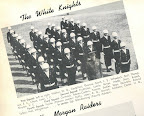
Mary Ward Brown. (Credit: Jerry Siegel)
Born (1917)and raised in Hamburg, Alabama, near Marion in Perry County, Mary Ward Brown did not taste success as a modern fiction writer until she was in her sixties. By any standard, she is a major writer of fiction, her works having garnered some of the top national and state literary awards: the PEN/Hemingway Award, Harper Lee Award, Lillian Smith Book Award, Hillsdale Award for Fiction, and two Alabama Author Awards, among others.

Mary T. (Credit: Mississippi Public Broadcasting/Alabama Arts Council)
With the exception of a short sojourn in Auburn, Alabama, Mary T. has lived on her parents’ farm in Hamburg all of her life. She graduated from Perry County High School in Marion, where she edited the school newspaper, and from Judson College (1938), where she again edited the school newspaper, and where she studied English and Journalism. In 1939, she married Charles Kirtley Brown and moved to Auburn, Alabama, where her husband worked in public relations at Auburn University. Their son, Kirtley Ward Brown, MMI H'61, a prominent Marion/Perry County lawyer and law instructor here at MMI, was born in Auburn in 1942. When Mary’s father died some years later, the Browns moved back to Hamburg to manage the large family farm. Mary T. still lives and writes there today.
Although she had a few short stories published in the 1950s, Mary T. stopped writing to concentrate on her family and running the farm. Following her husband’s death in 1970 from lung cancer, she began writing again, publishing in various national magazines.
In 1986, Tongues of Flame (E. P. Dutton), a collection of short stories, was published to wide literary and public acclaim.
In the mid-1980s, one of her short stories, “The Cure,” was included in an anthology of American and Russian writers. Traveling with this project, Mary T. toured the Soviet Union.
A second collection of stories was published in 2002. It Wasn’t All Dancing and other Stories was published by the University of Alabama Press some twenty-three years after her initial literary success. Her third work, Fanning the Spark: A Memoir, was published by Alabama in 2009.

Mary T.’s third book , Fanning the Spark: A Memoir (Alabama, 2009).
(Credit: The University of Alabama Press)
Mary Ward Brown’s literary themes and interests are usually set in the South during the 1950s to the early 1970s. They reflect the impact of societal changes on ordinary individuals including the persistence of racism and the unique role of religion in the South.

Mary T. signing her book. (Credit: Alabama Libraries)
A point of reference: All of the Brown Family have worked at MMI. Kirtley, MMI H'61, of course, teaches law at the Institute. His late father, Charles Kirtley Brown, worked with student publications including The Skirmisher, the cadet newspaper. Mary T. worked with John Moore (Ms. Woody’s husband) in the guidance and counseling office. Kirtley Brown’s wife, Susannah, also worked in the MMI Library with Ms. Woody. Finally, Mary T.'s nephew, Sheldon "Buzzie" Fitts, is a former MMI instructor.
In March, 2010, The Lyceum Council at MMI will host a celebration of the works of Mary Ward Brown with the presentation of the play, Ashes of Roses, in the MMI Chapel. Working in concert with the Marion Chamber of Commerce, Perry County Historical and Preservation Society, and other local organizations, a significant Arts Event highlighting Literature, Theater, Art and Music will be presented.









